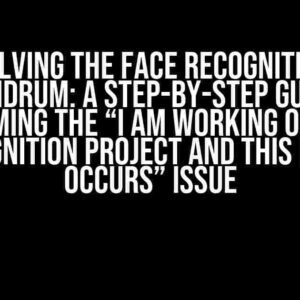Are you tired of encountering the annoying [SSL: CERTIFICATE_VERIFY_FAILED] error message every time you try to access a website or connect to a server? You’re not alone! This error can be frustrating, but don’t worry, we’ve got you covered. In this article, we’ll delve into the reasons behind this error and provide you with a comprehensive guide on how to fix it once and for all.
What is the [SSL: CERTIFICATE_VERIFY_FAILED] Error?
The [SSL: CERTIFICATE_VERIFY_FAILED] error occurs when your computer or server is unable to verify the identity of the website or server you’re trying to connect to. This usually happens when the SSL/TLS certificate presented by the server is not trusted or cannot be verified. The error message typically looks like this:
SSLError: [SSL: CERTIFICATE_VERIFY_FAILED] certificate verify failed: unable to get local issuer certificate (_ssl.c:1123)
Causes of the [SSL: CERTIFICATE_VERIFY_FAILED] Error
Before we dive into the solutions, let’s explore the common causes of this error:
- Missing or Expired SSL Certificate: If the website or server doesn’t have a valid SSL certificate or it has expired, your browser or application will throw this error.
- Misconfigured SSL Certificate: Incorrectly configured SSL certificates can also lead to this error.
- Outdated Root Certificates: If your system’s root certificates are outdated, it may not be able to verify the identity of the website or server.
- Firewall or Proxy Issues: Firewalls or proxies can sometimes block the SSL connection, resulting in this error.
How to Fix the [SSL: CERTIFICATE_VERIFY_FAILED] Error
Now that we’ve covered the causes, let’s move on to the solutions. Follow these step-by-step instructions to resolve the [SSL: CERTIFICATE_VERIFY_FAILED] error:
Method 1: Verify the SSL Certificate
First, let’s check if the website or server has a valid SSL certificate. You can use online tools like SSL Shopper or SSL Checker to verify the certificate:
https://www.example.com
Replace example.com with the website or server you’re trying to access. If the certificate is valid, you should see the certificate details. If not, you may need to contact the website administrator or server owner to resolve the issue.
Method 2: Update Root Certificates
Outdated root certificates can cause this error. You can update your system’s root certificates using the following methods:
| Operating System | Update Method |
|---|---|
| Windows | Download and install the latest root certificates from the Microsoft Trusted Root Certificate Program. |
| macOS | Update your macOS to the latest version, which usually includes updated root certificates. |
| Linux | Update your system’s certificate store using the following command:
sudo update-ca-certificates |
Method 3: Disable Certificate Verification
This method is not recommended, as it compromises the security of your connection. However, if you’re in a development environment or testing scenario, you can disable certificate verification temporarily:
import ssl
try:
_create_unverified_https_context = ssl._create_unverified_context
except AttributeError:
pass
else:
ssl._create_default_https_context = _create_unverified_https_context
This code snippet disables certificate verification for Python. Note that this is not a recommended solution for production environments.
Method 4: Check Firewall and Proxy Settings
Sometimes, firewalls or proxies can block the SSL connection. Check your firewall and proxy settings to ensure they’re not interfering with the connection:
- Check your firewall settings to ensure it’s not blocking the SSL connection.
- Verify that your proxy settings are correct and not interfering with the connection.
- Try disabling your firewall or proxy temporarily to see if the error persists.
Conclusion
The [SSL: CERTIFICATE_VERIFY_FAILED] error can be frustrating, but it’s usually a sign of a broader issue with the website or server’s SSL certificate. By following the methods outlined in this article, you should be able to resolve the error and establish a secure connection. Remember to always prioritize security and avoid disabling certificate verification in production environments.
If you’re still encountering issues, feel free to share your experience in the comments below. We’d be happy to help you troubleshoot the problem!
Keywords: SSL, certificate verify failed, unable to get local issuer certificate, SSL error, certificate verification failed.
Frequently Asked Question
Stuck with the frustrating [SSL: CERTIFICATE_VERIFY_FAILED] error? Don’t worry, we’ve got you covered! Here are some frequently asked questions to help you troubleshoot and fix the issue.
What does the [SSL: CERTIFICATE_VERIFY_FAILED] certificate verify failed: unable to get local issuer certificate error mean?
This error occurs when Python can’t verify the SSL certificate of the website you’re trying to access. It’s usually because the certificate is missing or the trusted certificate authority (CA) is not recognized by your system.
Why is my Python script throwing this error?
Your Python script might be using the `requests` library to make an HTTPS request. If the certificate verification fails, you’ll see this error. It could be because the website’s certificate is not trusted or the CA bundle is outdated.
How do I fix the [SSL: CERTIFICATE_VERIFY_FAILED] error?
You can try a few solutions: 1) Update your system’s CA bundle, 2) Use the `verify=False` parameter in your `requests` call (but be cautious about security risks!), or 3) specify a custom CA bundle using the `verify` parameter.
Is there a way to bypass certificate verification temporarily?
Yes, you can use the `verify=False` parameter in your `requests` call, but keep in mind that this reduces the security of your connection. Only use this as a temporary workaround and make sure to fix the underlying certificate issue.
How do I update my system’s CA bundle?
The process varies depending on your operating system. For example, on Ubuntu-based systems, you can run `sudo update-ca-certificates`. On Windows, you can update the CA bundle using the Microsoft Update Catalog.

![Solving the Frustrating [SSL: CERTIFICATE_VERIFY_FAILED] Error: A Step-by-Step Guide Solving the Frustrating [SSL: CERTIFICATE_VERIFY_FAILED] Error: A Step-by-Step Guide](https://shalamar.hkhazo.biz.id/wp-content/uploads/sites/817/2024/07/solving-the-frustrating-ssl-certificate_verify_failed-error-a-step-by-step-guide-with-text.jpg)
